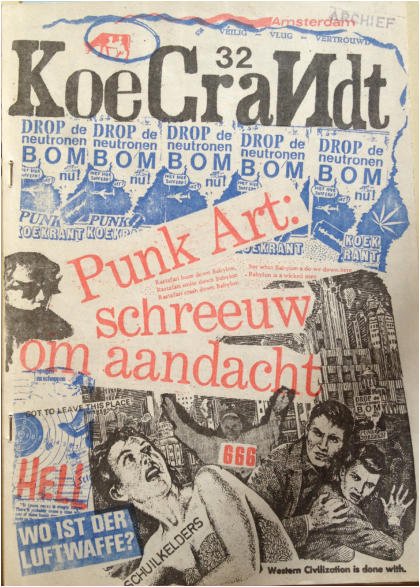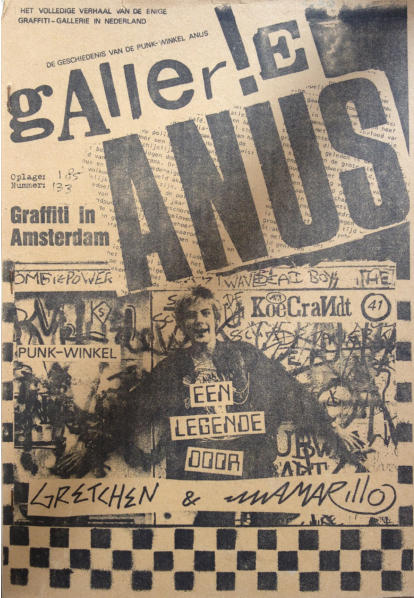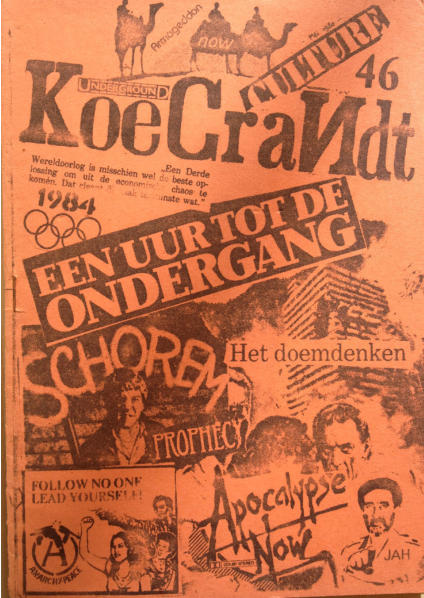
HUGO KAAGMAN STENCIL KING
The Hugo Kaagman Punk Files
Introduction
This is an exceptional artist’s edition, entitled Punk Files. This edition mainly features works created between 1977 and
1982 and were specifically intended for fanzines like KoeCrandt.
1977 KoeCrandt
Hugo Kaagman (1955) is one of the key figures of the Amsterdam punk movement. While
studying social geography at the city’s municipal university, he became interested in art
movements like Dada and Fluxus. While Malcolm McLaren was inspired by the French
Situationists, Kaagman was captivated by the disrupting work of artists like Wim T. Schippers and
Willem de Ridder and Provo too. Fluxus, an art movement whose roots can be traced back to
music, turned against the art establishment. Instead of pursuing a career, Fluxus artists made silk
screened T-shirts and spread their output as books and games via mail order, the Fluxshop.
Provo had a much more anarchistic outlook, but also this movement had a playful side. Their
activities were unsettling to a large extent: the establishment didn’t know how to deal with them
nor didn’t have an answer.
In 1976, Kaagman conducted a Fluxus inspired action: two students were hired to march through
the streets of Amsterdam with the text Vive les Étudiants. During the spring of 1977, Kaagman
and several other squatters occupied several houses in the Sarphatistraat. Later on, because of
Kaagman’s black and white graffiti, these became known as the Zebrapanden (zebra houses).
Kaagman’’s disappointment with the hippie movement resulted in a haircut, but his moment of
enlightenment came when a roommate handed him some punk pamphlets from London. Straight
away, Kaagman adopted the nickname of Amarillo and set up his own magazine, amongst others
with the Surinam sociology student Ludwig Wisch (aka Lulu Zulu),. The KoeCrandt or Koekrant or
Koekrand – named after the filthy leftovers in the toilet – was initially a mere house bulletin, but
later on ever more punk texts and images were included. A couple of months later, ex Rietveld
Academy student Diana Ozon also became involved with the magazine. In the beginning of 1978,
Ivar Vics, alias Dr Rat (1960-1981) joined the group too. The Koecrandt featured collages, poems
by Ozon, comics by Amarillo, drawings by Dr Rat and reviews of concerts and disturbances
caused by punks.
1978 DDT666
In April 1978, Kaagman and Ozon set up the DDT666 punk club in the basement of their
Sarphatistraat squat. DDT666 stood for: Dirty Dutch Trix. Kaagman remembers those days as,
‘Everybody was really energetic and that lazy hippie attitude had vanished completely. Everyone
was writing on the walls. I was truly convinced that I was witnessing the beginning of a new
movement.” But, after just half a year DDT666 had ceased to exist.
1979 Gallery ANUS
In 1979, Kaagman and Ozon opened the Anus Gallery at the same location. Apart from selling
punk magazines and homemade T-shirts, it was also possible to get a haircut. The gallery
became a meeting place for punks from all over the Netherlands. Kaagman had pinned a map of
the country on the wall which was covered with lots of little flags indicating where the visitors
came from. Over time, the gallery became the operating base for both graffiti artists and/or graffiti
vandals. Thanks to Hugo Kaagman, graffiti became an essential part of the Amsterdam punk
movement. Indeed, in contrast to other countries, punk and graffiti became closely associated in
the Netherlands. Elsewhere, graffiti was considered to have originated within the hip-hop
movement.
In 1978, Kaagman organized the Grand Prix du Graffiti. Victor Vics, alias Dr Rat, won first prize.
The year after, the event became hugely popular. Lots of young ‘artists’ joined in, but most of
them made a mess of it. It is not farfetched to dub Kaagman the founder of the Dutch graffiti
scene. Internationally, he is seen as the pioneer of stencil graffiti: his murals are made with the aid
of self-made stencils.
There is an unexpected link between punk and reggae. Just like in London, many punks in
Amsterdam were fond of reggae. They identified with reggae’s rebellious spirit and just like the
Rasta’s were drawn to the imminent apocalypse. Both Kaagman and Ozon reported regularly on
those themes in the KoeCrandt.
1980 Gallery Ozon
In January 1980, gallery Anus was closed, but a couple of months later Kaagman and Ozon set
up gallery Ozon. Sarphatistraat 62 was no longer a hangout for punks, on the contrary. It became
a serious gallery with both stencils and spray art. Every day, Kaagman produced new stencils and
these were applied to any surface. The façade of their house was a huge colourful collage: punk
and Rasta motifs and images of the jungle. Tigers, panthers, snakes and zebras were competing
for attention. In the meantime, the gallery was selling T-shirts and fanzines, whereas the
KoeCrandt was also being published.
1981 Gallery Zebra
In 1981, the name of the gallery changed just once more. The Ozon gallery became the Zebra
gallery. After a long trip through Africa, via Timbuktu to Morocco, Kaagman decided that the time
had come to adopt a positive attitude. He started combining jungle motifs with decorative patterns
and the façade of Sarphatistraat 62 changed once again. Kaagman applied lots and lots of zebra
motifs and the gallery became a serious enterprise with real artists. A group was formed in the
Cobra spirit: let’s move on together. Apart from Fabiola and Mike von Bibikov, lots of post punks
were both members and regular visitors. Johan van Leeuwen took over the KoeCrandt and
Kaagman initiated the Zebra magazine where all sorts of topics were being raised. Performances
were held in the gallery as well and every now and then the group went elsewhere to manifest
itself. Also, some other magazines, notably the Escapist and Argwaan, were published. The
Zebra House kept its name until it was demolished in 1996.
Collages
Kaagman’s art, developed during the punk movement, is based on the collage technique. He
made the Koecrandt fanzine with photocopied cuttings from newspapers and he applied the same
procedure to his stencils. To him, a collage made up of pictures is much more effective than just
lots of words. The doomsday images in gallery Anus were taken directly from the printed media;
the Ozon gallery also displayed cheerful pictures while really new fashion was being made too.
Only in the Zebra gallery, autonomous art was shown.
1983 Fences and railings
In 1983, Kaagman was commissioned by the Wijkcentrum d’Oude Stadt (the old town
neighbourhood centre) and the neighbourhood group Amstelstraat to paint an 80 metre long
fence, just in front of the Stopera (an abbreviation of Stadhuis (town hall) and Opera, a building
that was under construction those days). The fence became a huge collage containing punk
elements, Moroccan and jungle motifs. A part of it featured the black and white zebra style. ‘I just
hope that this kind of art will spread all over the city and will be considered as an attraction by
itself and not just as a way of filling space. Within the official art world, the in-crowd, my work isn’t
taken seriously at all. Yet, on the street, we get a lot of positive vibes and every day more
appreciation’, Kaagman said.
Other official assignments followed soon afterwards. In 1985, he was commissioned by the
Municipality of Amsterdam to take charge of the Transvaal tunnel near the Wibautstraat.
Kaagman incorporated all afore mentioned elements, but he was also influenced by North-
American graffiti. His next step was getting involved with the official gallery world. After all, the Do
It Yourself attitude was completely gone and the days of the Yuppies had arrived. Lots of money
was made with art and the idea of wanting to do everything yourself was considered to be just
terribly pitiful. In January 1988, Kaagman exhibited his one square meter paintings in the Living
Room gallery, the emphasis being on decorative expression. The year after, he had another solo
show in the same gallery. The works on display contained a mix of all the idioms he had
developed so far.
In 1990, Kaagman was awarded a grant to develop his talent even further. He then asked himself
why he was always looking for decorative motifs elsewhere. Thus, he started doing research in
the Netherlands and discovered the Delft blue tradition. He gave it a new life by turning everything
upside down. Collage was still the basis for his compositions and with lots of tiny elements he
made great new images. Also, his punk roots and research into world religions came into play.
These were still visible in meaningful messages.
Kaagman became internationally successful with his Delft blue style. He got lots of commissions,
amongst others, a well over 60 meter long mural at Schiphol airport, nineteen Boeing aeroplane
tails for British Airways and murals in Japan, Russia and the United States of America.
It is not uncommon that much of the later work of quite a few artists is closely related to the
applied arts. For example, they became famous for their paintings and/or sculptures and then got
the opportunity to decorate the outer walls of buildings or their work is being reproduced on ties
and maybe every now and then they get a commission to design a record cover. For Hugo
Kaagman the opposite is true because his work was born in the streets. If he gets an assignment
to take on a fence, a wall or, in the case of the energy company Essent in the city of Enschede, a
whole building, he is creating autonomous art. His works on canvas were made in a later stage;
their origins go back to street art.
There have been followers, of course. Elements from Kaagman’s idiom were and are still
regularly being used in advertisements, either with or without permission. Both design fairs and
interior design shops feature works in the Kaagman style and these are usually labelled with the
name of some other artist. In general, Kaagman isn’t too worried by this; at most he is annoyed
by the quality of the copied product.
In the beginning, Kaagman photocopied images and often enlarged them. Especially, the library
proved to be a good source, but from the nineteen nineties onwards the computer became really
helpful. The artist started scanning his images and was able to manipulate his collages a lot
more. Photoshop allowed him to create collages without scissors and glue. This proved to be a
real solution because the collages didn’t get damaged when Kaagman reused them for other
compositions. He also started scanning his stencils, first to make sketches for murals and later on
as a base for only digitally existing compositions.
Kaagman’s oeuvre refers constantly to former idioms, but he also includes new ones. Therefore,
both punk and Rasta remain an important source of inspiration, just like Arabic and Dutch motifs.
Later on he also included Japanese, Ethiopian and French motifs. Then he started investigating
so-called Geo-graffiti, making fictitious atlases. But even this subject is within his range. After all,
Kaagman was once a social geography student and took up travelling at an early age.
This is a very special artist’s book, a limited handmade edition (.. copies only). It provides insight
into how Kaagman developed his style throughout the years and, moreover, also features his best
collages. Some date back to the beginning of his career and were made with the help of scissors
and glue. Most are either an update of former material or new digitally designed images. This
edition provides an exceptional overview of the oeuvre of an inspiring and dedicated artist.
Kaagman has also been named the Stencil King and rightly so. He started out in the days when
graffiti became a force to be reckoned with, but in contrast to most street artists he worked with
stencils. Also, internationally he was one of the first to do so. Kaagman’s work is admired by
artists like Banksy, by whom he is seen as a precursor.
Punk in Holland, Jeannette Dekeukeleire and Harry Ruhé. Published by DeCultClub, September
2011. Binding: file, 100 pages. ISBN
No future nu, Leonor Jonker. Published by Lebowski, February 2012. Binding: paperback. 192
pages. ISBN
Stencil King – Hugo Kaagman, Published by Lebowski, November 2009. Binding: paperback,
160 pages. ISBN




PUBLICATION LIST 1977 – 1981
(Hugo Kaagman, Diana Ozon, Ivar Vičs, Ludwig Wisch, Christian Cannstatt, Johan van Leeuwen)
TITEL REDACTIE/AUTEUR(S) OPLAGE (DATUM)
Bab Boujeloud-boek Kaagman 100 (juni 1977)
Koekrant 1,2,3,4 Kaagman/Cannstadt (1977)
Coeqrand 5 Kaagman/Cannstadt 20 (aug.1977)
Koekrant 6 Kaagman/Cannstadt/Ozon 100 (sep.1977)
Fotocopy geldbrillen Kaagman 25 (okt.1977)
Kraakkrant nr.16 Koekrandt redactie ? (okt.1977)
Koecrandt 7-Verfincident Kaagman 20 (okt.1977)
Coekrandt 8-paviljoen 3 Kaagman/Cannstadt 20 (okt.1977)
4 verschillende colorcopy's Kaagman 50 (nov.1977)
Erik Satie-stripverhaal Kaagman 100 (nov.1977)
Koekrandt informatie pamflet Kaagman/Cannstadt/Wisch 200 (dec.1977)
Koekrant kalender(groot) Kaagman 200 (dec.1977)
De avonturen van God-strips Kaagman/Ozon 100 (dec.1977)
Deutschland special Kaagman/Cannstadt 100 (jan.1978)
Gedichten (18) Ozon 100 (feb.1978)
Koekrant kalender(klein) Kaagman 100 (feb.1978)
Marokko fragmenten Kaagman 100 (mrt.1978)
Olie Buma Zomerpretboek-strip Kaagman 100 (mei.1978)
Midnight extra-proza Ozon 100 (mei 1978)
7 verschillende stickervellen Kaagman/Vics/Ozon 100 (1977/78)
Secret life of Bwana 5 foto’s Kaagman 100 (apr.1978)
Christian Cannstadt-poëzie Cannstadt 100 (jun.1978)
Drop de N-bom posters fotocopy Kaagman/Ozon 100 (mei 1978)
Bijbel deel III strips Kaagman/Ozon 100 (mei 1978)
Bwana 5 special foto's Kaagman 100 (apr.1978)
Crisis Time-poëzie Ozon 100 (mei 1978)
Lucy Seven Ivar Vics 100 (mei 1978)
Koopmanshuis brochure Kaagman 50 (feb.1978)
Blondie I Kaagman/Cannstadt/Wisch 100 (dec.1977)
Blondie II Kaagman/Cannnstatt/Ozon/Wisch 200 (jan. 1978)
Koekrant/Blondie art-o-maat-vel Cannstadt 100 (feb.1978)
Blondie III Kaagman/Ozon/Wisch/Vics 200 (mrt.1978)
Koekrant 20 Kaagman/Cannstatt/Wisch/Vics 100 (mrt.1978)
Lidmaatschapskaart DDT 666 Vics 100 (apr.1978)
Bijbel deel III Nieuw Kaagman/Ozon 300 sept 1978
Koekrant-guide to Amsterdam Kaagman/Cannstatt/Ozon/Wisch 100 (mei 1978)
Koekrant 21 Kaagman/Cannstatt/Ozon/Wisch/Vics 65 200 (mei 1978)
KoeCrandt 22 Kaagman/Ozon/Wisch/Vics 100 (mei 1978)
Disco krant nr 1 Kaagman/Ozon 100 (sept 1978)
Verzamelboek de Punkmachine Allen-samenstelling Kaagman 15(aug.1978)
KoeCrant 25 Kaagman/Ozon 150 (sept.1978)
KoeCrandt 26 Kaagman/Cannstadt/Ozon 100 (okt.1978)
Trekwerk wit Cannstadt ? (nov. 1978)
KoeCrant 27/28 Vics 200 (jan.1979)
KoeKrant 29 Vics 400 (apr.1979)
Badges/zeer veel,div techniek Kaagman duizenden (1979/80)
KoeCrand 30 Kaagman/Ozon 500 (apr.1979)
Zand uit Sahara kaart Kaagman/Ozon 10 (apr.1979)
KoeKrand 31 Kaagman/Ozon 250 (mei 1979)
Rasta Invitatie Kaart-Anus Kaagman/Waldaab 50 (mei 1979)
Ride the lion to zion-poëzie Ras Waldaab/Kaagman 150 (juli 1979)
Papua Punk Koekrandt 13 Kaagman 150 (mei 1979)
Sperma Songbook Ozon/Wim Sperma 150 (juni 1978)
Drop de Neutronenbom poster Kaagman&onbekende 3000 (aug.1979)
Anus enquete onder bezoekers Ozon 200 (sept 1979)
Uitslag grand prix grafitti a-dam graffitiërs/kaagman 500 (mei 1979)
Stickervel Kaagman 100 (aug.1979)
2 galerie Anus reklame vellen Kaagman 500 (1979)
Dub-club-poster-Paradiso Kaagman 500 (juli 1979)
Koecrandt 32 Kaagman/Ozon 300 (juli 1979)
KoeCrandt 33 Kaagman/Ozon 300 (aug.1979)
KoeCrandt 31 Kaagman/Ozon 350 (sep.1979)
KoeCrandt brillen 3 soorten Kaagman/Ozon 33 (nov.1979)
Koekrant 35 Foto Anaal Kaagman/Vunderink 94 (nov.1979)
KoeQrandt 46 Kaagman/Ozon 150 (nov.1979)
Koekrant 38 Johan v.Leeuwen 150 (dec. 1979)
Stickervel Kaagman 50 (dec.1979)
Kalender 1980 Kaagman 100 (dec.1979)
Nieuwjaarskaarten 4 stuks Kaagman 30 (dec.1979)
KoeCrandt 39 Kaagman/Ozon 400 (dec.1979)
Koekrant 37 Vics 100 (Jan.1980)
KoeKrant 40 Johan 250 (Jan.1980)
Anus legende Koecrandt 41 Ozon/Kaagman 150 (feb.1980)
KoeKrant 42 Johan 300 (mrt.1980)
De Tachtiger, Koekrant 43 poëzie Ozon 300 (apr.1980)
KoeKrant 45 Dia Show Paradiso Dub Club Kaagman 1 (29-4-1980)
CoeCrant 44 Vics ? (30-4-1980)
KoeCrandt 46 Kaagman/Ozon 400 (mei 1980)
Beatrix kaarten 4 stuks Kaagman 1000 (april 1980)
Stickervel Kaagman 100 (april 1980 )
3 gallerie Ozon reklame vellen Kaagman 1200 (1980)
KoeKrant 47,48,49 Johan 500 (1980)
KoeCrant 50 Kaagman/Ozon 400 (sept 1980)
Chaos in de rechtstaatposter Kaagman/Edje Cholera 1000 (april 1981)
Doemdenk magazine I Kaagman 50 mei (1981)
Doemdenkkrant 2 Kaagman 50 mei (1981)
Komies boek strips Kaagman 50 (mei 1981)
Meidenwerk Poezie/proza 0zon 400 (mei 1981)
Ghetto stylee foto's Kaagman/Vermeulen 22 (juli 1981)
Maroc, Kaagman 100 (feb.1982)
De Escapist Kaagman/Ozon/Plomp 50 (dec.1981)
Psychedelic Pattern Design 1 Kaagman 10 (1982)
Psychedelic Design 2 Kaagman 10 (1983)
Motieven-Azuleos in Portugal Kaagman 50 (okt.1983)
European Graffiti Kaagman 5 (1983)
Graffiti Waterlooplein Kaagman 2 (1984)
Nieuwjaarskaarten 8 div. Kaagman 30 (dec.1983)
Diana Ozon gedichtvelletje Kaagman 200 (maart 1982)
Poster laag bij de gronds Kaagman 50 (1982)
Poster de obscure camera Kaagman 50 (sept.1983)
Argwaan 1 Magazine Kaagman/Ozon 100 (maart 1984)
8 schuttingkaarten Kaagman 1000 (april 1984)
Tubifex –dichtbundel Kaagman 50 (juni 1984)
Tubifex –cassette Kaagman v.a. 5 (juni 1984)
De Nieuwe Koekrant Johan/Charlotte 500/ vanaf nr 52 1000 (1980)
Papua Punk-best of KoeCrandt samenstelling Kaagman 1000 (1982) uitg.de Woelrat
Laag bij de gronds-poëzie Ozon 700 (1982) Uitgeverij Guus Bauer
Laag bij de gronds-cassette Ozon/Wisch-cover/Kaagman (1982) uitg.Blessure Records
